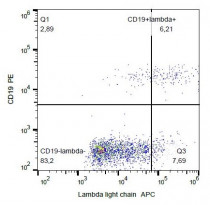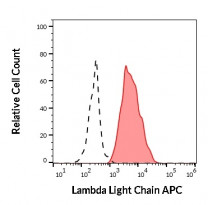ARG53954
Mouse anti-Human Lambda Light Chain antibody [4C2] (APC)
Mouse anti-Human Lambda Light Chain antibody [4C2] (APC) for Flow cytometry and Human
Immune System antibody
Overview
| Product Description | APC-conjugated Mouse Monoclonal antibody [4C2] recognizes Human Lambda Light Chain |
|---|---|
| Tested Reactivity | Hu |
| Species Does Not React With | Goat, Gpig, Hm, Rb, Sheep |
| Tested Application | FACS |
| Host | Mouse |
| Clonality | Monoclonal |
| Clone | 4C2 |
| Isotype | IgG1 |
| Target Name | Lambda Light Chain |
| Antigen Species | Human |
| Target Ig | Human Lambda light chains |
| Conjugation | APC |
| Alternate Names | IGL@; IGLC6 |
Application Instructions
| Application Suggestion |
|
||||
|---|---|---|---|---|---|
| Application Note | * The dilutions indicate recommended starting dilutions and the optimal dilutions or concentrations should be determined by the scientist. |
Properties
| Form | Liquid |
|---|---|
| Purification Note | The purified antibody is conjugated with cross-linked Allophycocyanin (APC) under optimum conditions. The conjugate is purified by size-exclusion chromatography and adjusted for direct use. No reconstitution is necessary. |
| Buffer | PBS, 15 mM Sodium azide and 0.2% (w/v) high-grade protease free BSA |
| Preservative | 15 mM Sodium azide |
| Stabilizer | 0.2% (w/v) high-grade protease free BSA |
| Storage Instruction | Aliquot and store in the dark at 2-8°C. Keep protected from prolonged exposure to light. Avoid repeated freeze/thaw cycles. Suggest spin the vial prior to opening. The antibody solution should be gently mixed before use. |
| Note | For laboratory research only, not for drug, diagnostic or other use. |
Bioinformation
| Database Links | |
|---|---|
| Gene Symbol | IGL |
| Gene Full Name | immunoglobulin lambda locus |
| Background | Immunoglobulins recognize foreign antigens and initiate immune responses such as phagocytosis and the complement system. Each immunoglobulin molecule consists of two identical heavy chains and two identical light chains. There are two classes of light chains, kappa and lambda. This region represents the germline organization of the lambda light chain locus. The locus includes V (variable), J (joining), and C (constant) segments. During B cell development, a recombination event at the DNA level joins a single V segment with a J segment; the C segment is later joined by splicing at the RNA level. Recombination of many different V segments with several J segments provides a wide range of antigen recognition. Additional diversity is attained by junctional diversity, resulting from the random additional of nucleotides by terminal deoxynucleotidyltransferase, and by somatic hypermutation, which occurs during B cell maturation in the spleen and lymph nodes. Several V segments and three C segments are known to be incapable of encoding a protein and are considered pseudogenes. The locus also includes several non-immunoglobulin genes, many of which are pseudogenes or are predicted by automated computational analysis or homology to other species. [provided by RefSeq, Jul 2008] |
| Research Area | Immune System antibody |
Images (3) Click the Picture to Zoom In
-
ARG53954 Mouse anti-Human Lambda Light Chain antibody [4C2] (APC) FACS image
Flow Cytometry: Human peripheral whole blood stained with ARG53954 Mouse anti-Human Lambda Light Chain antibody [4C2] (APC) (10 µl reagent / 100 µl of peripheral whole blood).
-
ARG53954 Mouse anti-Human Lambda Light Chain antibody [4C2] (APC) FACS image
Flow Cytometry: Human peripheral blood stained with ARG53954 Mouse anti-Human Lambda Light Chain antibody [4C2] (APC).
-
ARG53954 Mouse anti-Human Lambda Light Chain antibody [4C2] (APC) FACS image
Flow Cytometry: Separation of Human Lambda Light Chain positive B-Lymphocytes (red) from Human Lambda Light Chain negative B-Lymphocytes (black-dashed). Human peripheral whole blood stained with ARG53954 Mouse anti-Human Lambda Light Chain antibody [4C2] (APC) (10 µl reagent / 100 µl of peripheral whole blood).








